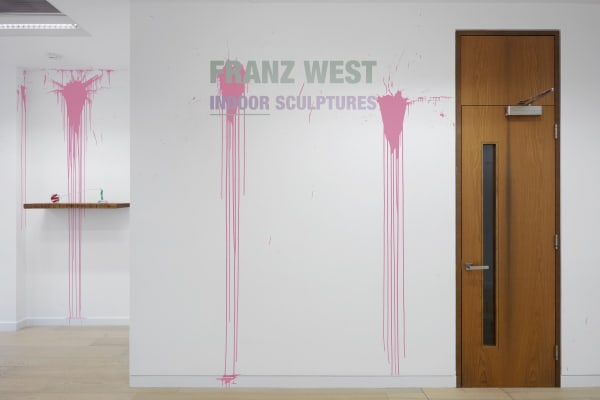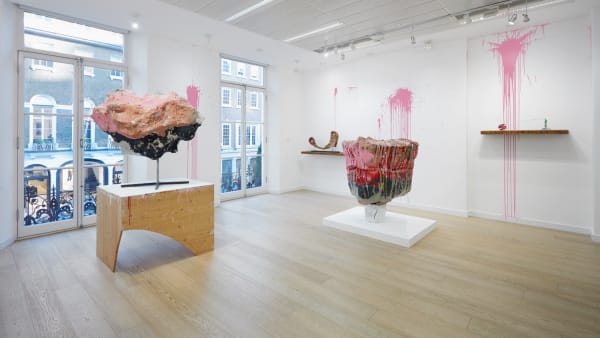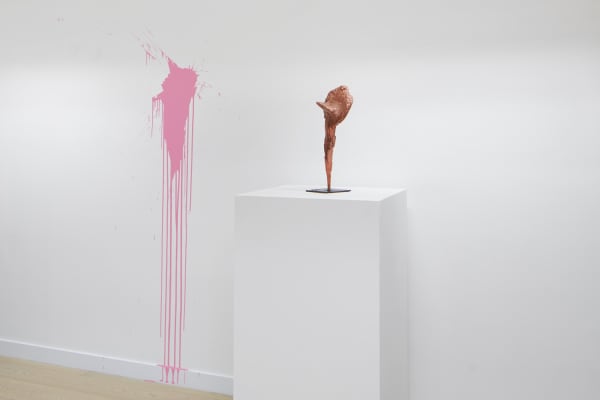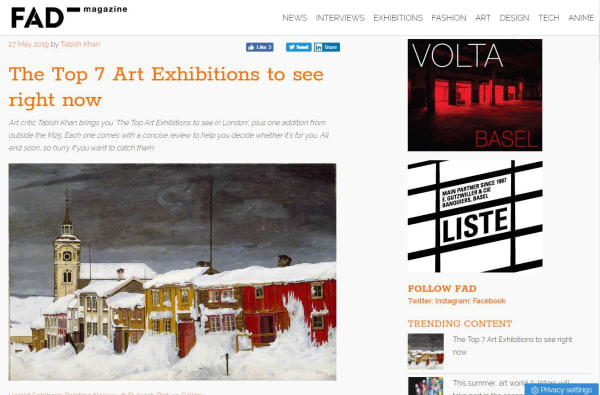Franz West: Indoor Sculptures
Omer Tiroche Gallery is pleased to announce a retrospective exhibition of Franz West indoor sculptures. The featured works span three decades of his career – from 1980 to 2010 – and showcase the development of his legendary papier-mâché sculptures. From his early Adaptives, also known as Paßstücke, through his progression into what he called Legitimate Sculptures, this exhibition will serve as a mini survey to coincide with the retrospective being held at the Tate Modern.
Internationally celebrated for his humorous and playfully ambiguous sculptures, Franz West revolutionised the concept of sculpture through his pioneering efforts that explored the relationship between art and the viewer. West was heavily influenced by various performance art movements of the 1960s, including the Viennese Actionists, which he reinterpreted into his interactive papier-mâché Adaptives series. With this breakout body of work, West redefined the spectator’s experience with sculpture by creating an active dialogue between the two. Believing that art should have a function, West’s sculptures are both physically and intellectually immersive for the viewer, and it is through his experimental and innovative use of form, materials, language, and colour that West set a new precedent for sculpture from the second half of the twentieth century.
West began constructing his sculptures in the mid 1970s, and by using papier-mâché, wire, plaster or polyester, he could easily sculpt abstract organic forms that would later harden to become rock solid. Light-weight and only a few feet in size, these portable sculptures are interactive, demanding the viewer’s intervention rather than observation. West famously stated that “it doesn’t matter what art looks like but how it’s used”, arguing that there is beauty in function. The participation of the viewer is paramount and only by holding, touching, wearing or using the artwork in some way are the Adaptives deemed complete. Untitled (Hat), 1983, is a prime example of this key feature as well as how West used mundane found objects in his sculptures. He playfully transformed them into something unfamiliar yet recognisable by reattributing their context. Although most Adaptives are painted white, the use of pink was significant for West as it references his mother’s dental clinic, with pink being the colour of dentures and gums.
During the latter part of 1980s, West’s artistic vision, which necessitated interaction between sculpture and audience, was at odds with the desires of commercial galleries, who preferred the works to remain untouched and to be displayed traditionally in order to maintain their financial value. West decided that if his pieces could not be exhibited in the way that he intended, he too would adapt. In 1986 at the Neue Galerie in Graz, he debuted a new series of works in an exhibition with the self-mocking title, Legitimate Sculptures. These vague, bulbous forms were created predominantly from painted papier-mâché and often mixed with polystyrene, cardboard, wood and steel. Larger in scale, they regularly sit perched atop handmade plinths or stands that accompany the works. In contrast to the Adaptives, they were no longer easy to carry and too fragile to handle. These works were mottled in brightly coloured reds, greens, pinks and blues applied in thick layers that defied gravity by dripping in all directions.
West strived for a more critical analysis of his sculptures from the spectator. He recanted on his previous invitation to touch the works, this time visitors were requested to interact intellectually instead of physically. These sculptures reach their completion through the viewers’ examination and through the various chains of associations that are triggered whilst engaging with the work. As demonstrated with Untitled, 2007, the sculpture’s arbitrary form is immediately intriguing, as its bulky contours coax the viewer to investigate further and, in-so-doing, anthropomorphic qualities may start to manifest. Upon close inspection, one can make out a nose, an ear, or a chin, but as soon as one grasps the physiognomy they vanish like a mirage, and the whole work morphs into something else entirely, such as a meteorite or a giant tooth. West continued to vigorously evolve this series of sculptures up until his death in 2012.
The importance of colour, form and function is visually evident in West’s work, but equally important is his subtle use of language to provide multiple contexts for his arbitrary forms. West explored the various tools of semantics and applied to his work the theory that words are not fixed, but instead are dependent upon their context, thus allowing for multiple interpretations. Maulschelle, 1980, whose title loosely translates as ‘slap in the face’, is also the name of a small Bavarian town that is sometimes referred to as the Textile Town of Bavaria. Though the work can resemble a paddle or swinging pendulum, there is no single concept or prescribed meaning that West conveys in it. He demonstrates that ambiguity opens an infinite number of interpretations, which in turn creates personal dialogues with the viewers.
For Franz West, the exchange between viewer and artwork, be-it through touch or interpretation, formed the foundation of his practice. West’s innovative use of materials, form, colour and language, blurred the lines between sculpture and installation. As a result, West created new archetypes for sculpture that allowed the viewer to intervene and interact. His sculptures captivate us because, although they are inherently ambivalent, they provide small glimpses of recognisable shapes hidden in the contours of the works. They draw the viewer into a world that is both ambiguous and unnerving, and it is through these revolutionary constructs that he reconstructed our perception of sculpture.
-
 Franz WestMaulschelle, c.1980Plaster, metal, dispersion and mixed media17.1 x 61 x 10.2 cm.
Franz WestMaulschelle, c.1980Plaster, metal, dispersion and mixed media17.1 x 61 x 10.2 cm.
6 ¾ x 24 x 4 in.€ 50,000.00 -
 Franz WestUntitled (Hat), c.1983Papier-mâché on felt hat30 x 16 x 26 cm.
Franz WestUntitled (Hat), c.1983Papier-mâché on felt hat30 x 16 x 26 cm.
11 13/16 x 6 5/16 x 10 ¼ in.€ 40,000.00 -
 Franz WestUntitled (painted by Herbert Brandl), 1984Oil on cotton gauze on papier-mâché on artist's metal tablePapier Mache: 54 x 110 x 22 cm. // 21 ¼ x 43 5/16 x 8 11/16 in.
Franz WestUntitled (painted by Herbert Brandl), 1984Oil on cotton gauze on papier-mâché on artist's metal tablePapier Mache: 54 x 110 x 22 cm. // 21 ¼ x 43 5/16 x 8 11/16 in.
Base: 81 x 141 x 41 cm. // 31 ⅞ x 55 ½ x 16 ⅛ in.€ 150,000.00 -
 Franz WestUntitled, c.1988-1992Papier-mâché, plaster, metal and acrylic47 x 23 x 16 cm.
Franz WestUntitled, c.1988-1992Papier-mâché, plaster, metal and acrylic47 x 23 x 16 cm.
18 ½ x 9 1/16 x 6 5/16 in.$ 104,000.00
















